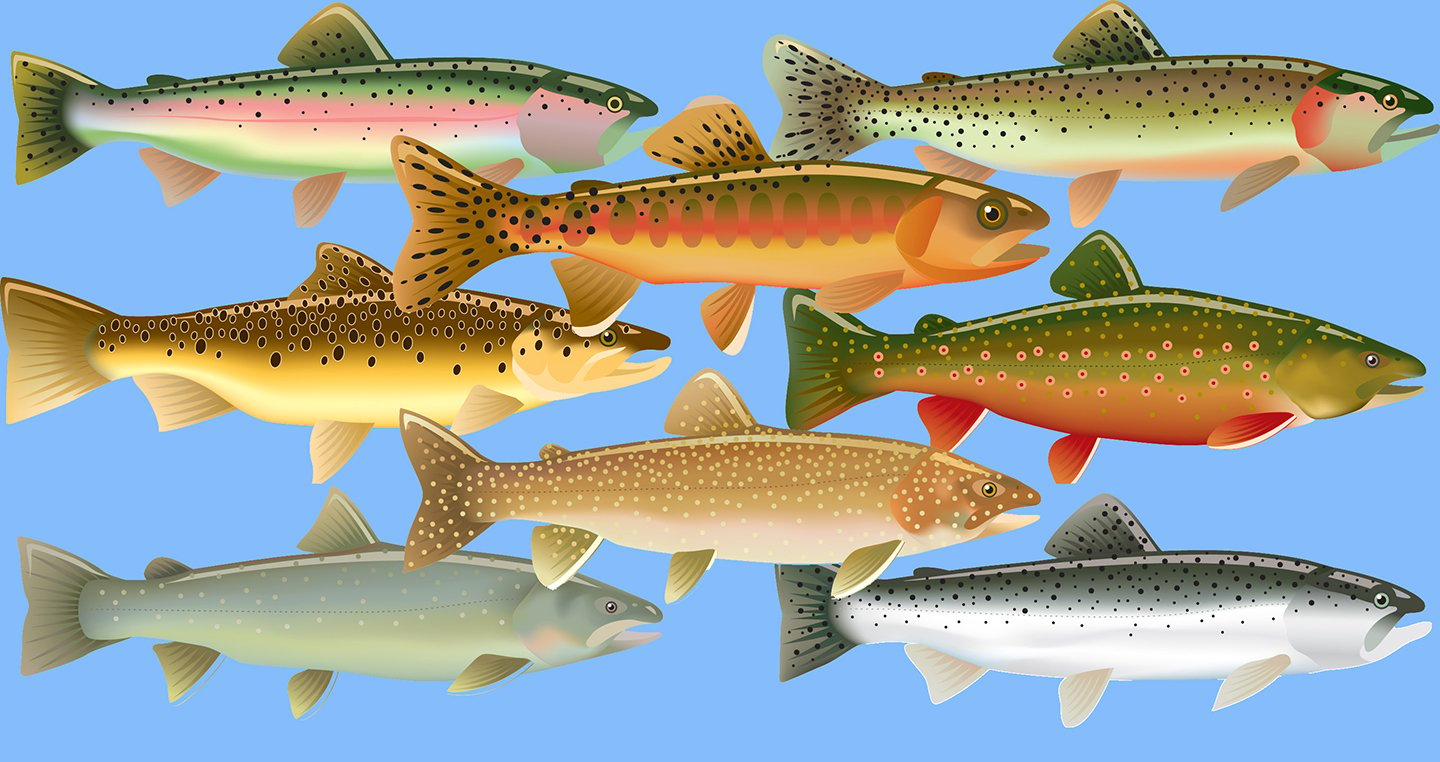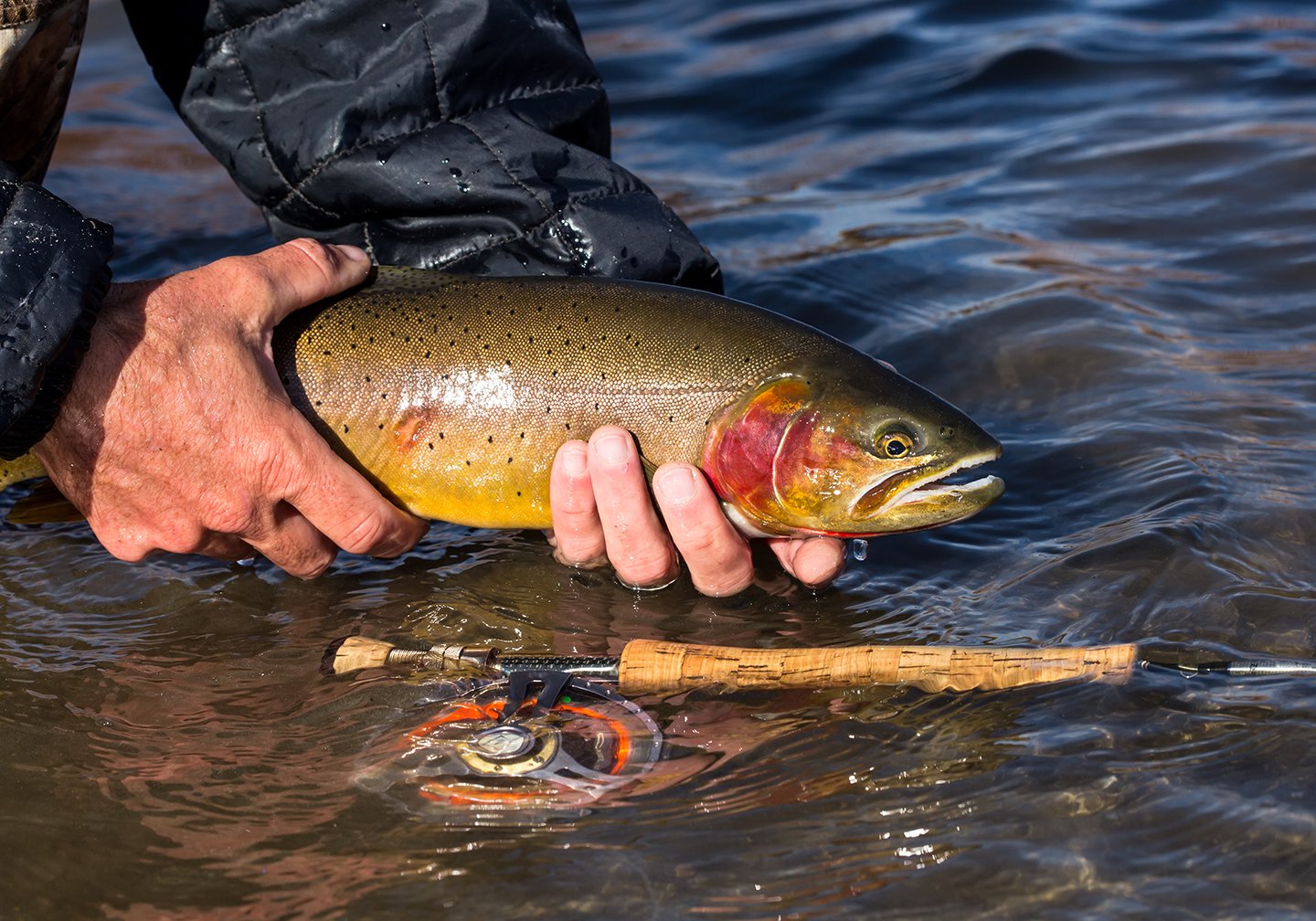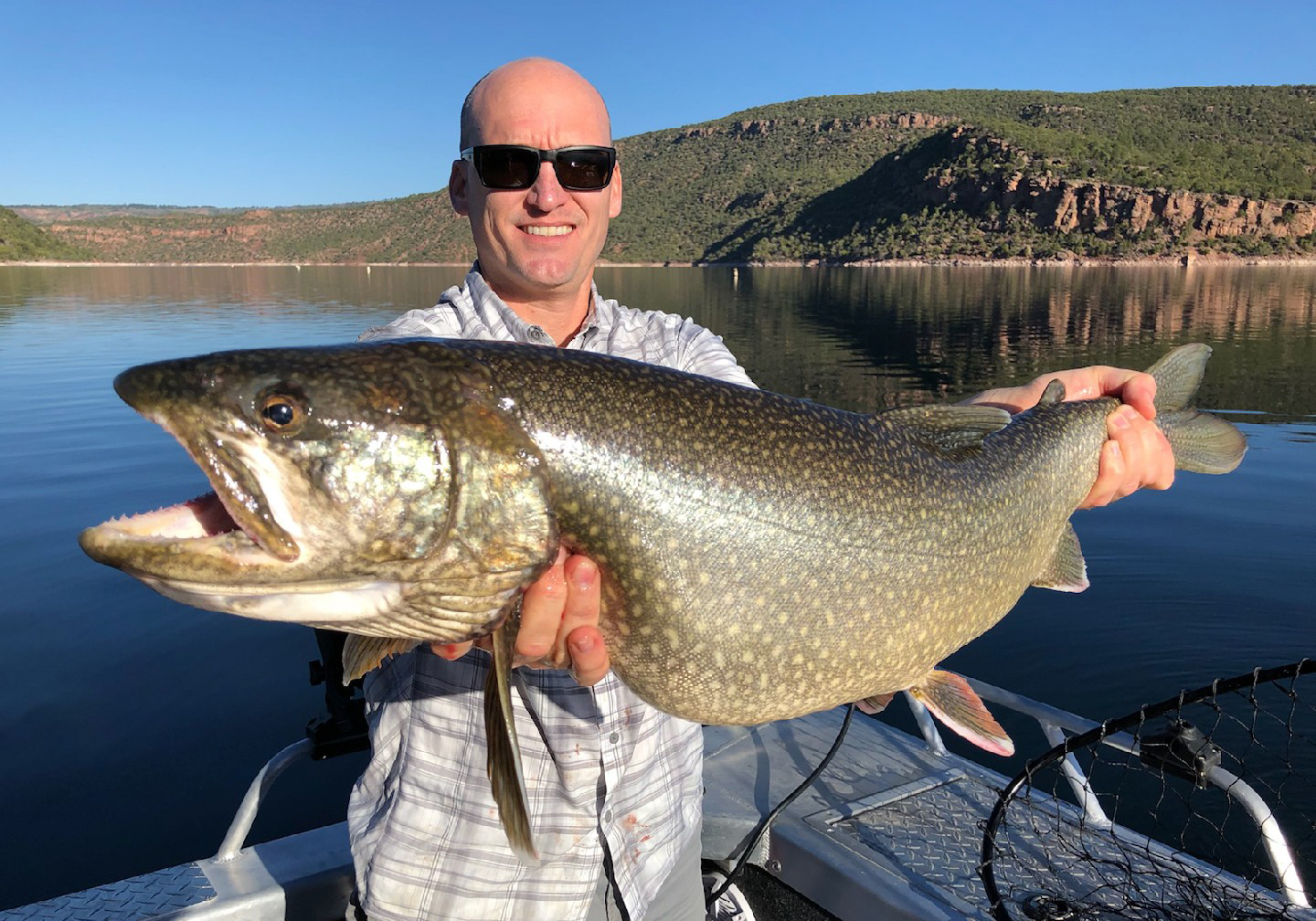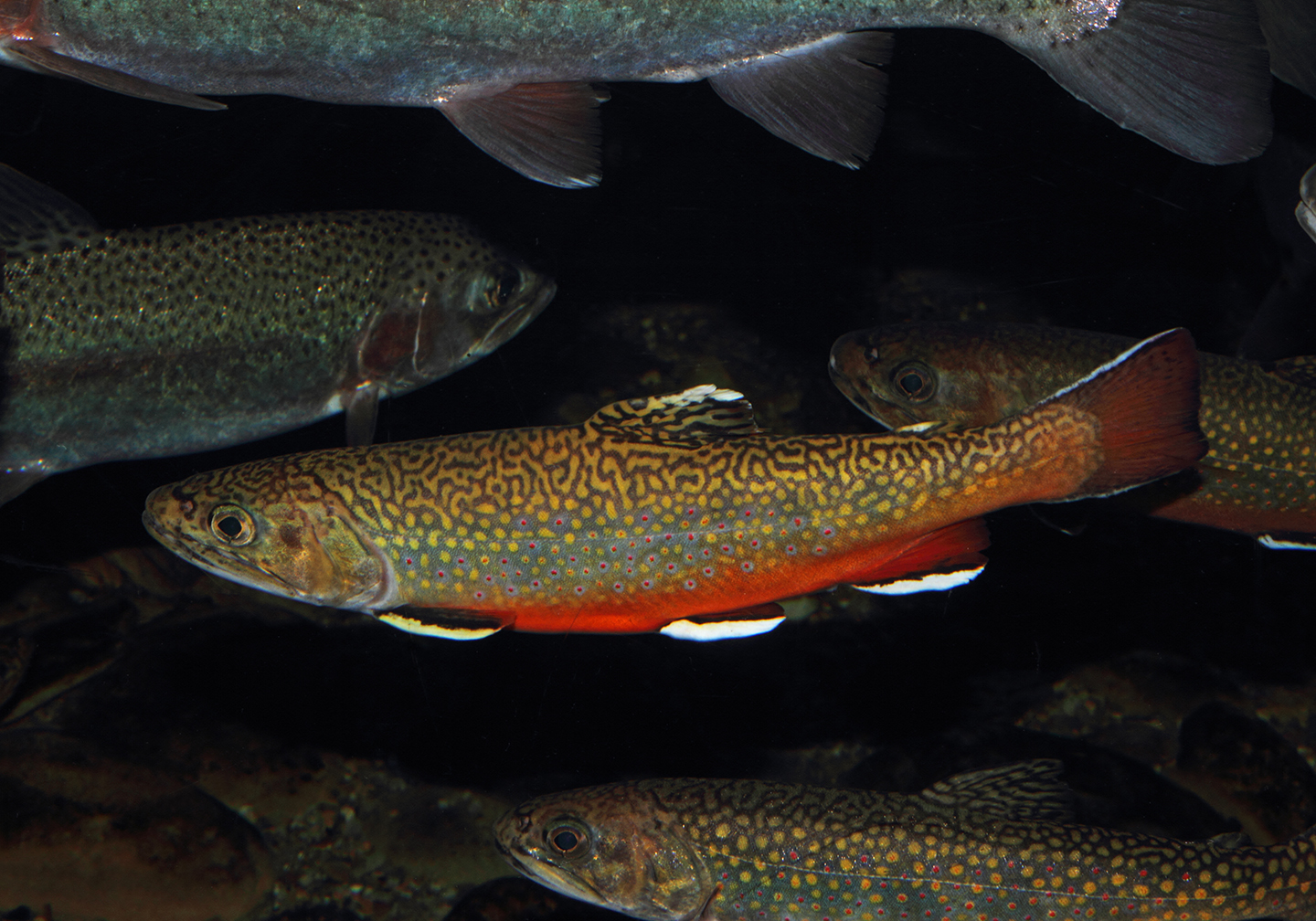How Many Babies Does a Trout Have at Once
Reading Time: 9 minutes
North America is a Trout fishing paradise. From remote mountain streams to swell rushing rivers, the waterways of the Usa and Canada are perfect for many unlike types of Trout. So many, in fact, that it can get pretty confusing. The various Trout of North America all look similar and often live in the aforementioned place, so how practice yous know what you're catching?

This guide volition give you some easy tips on knowing your Trout. Learn what lives where and how to tell it apart from everything else. Find out a little almost how the different Trout families fit together. You may be surprised to notice that your favorite fish aren't Trout at all!
The Natives: Pacific Trout
These guys are the undisputed kings of North American Trout fishing. They're corking to eat, even ameliorate to catch, and they have some real star appeal to boot. At that place are but 2 species of Pacific Trout in Due north America merely each fish varies hugely depending on where you grab it.
Rainbow Trout

Rainbow Trout are probably Northward America's all-time-known species. They become their name from the signature pink stripe that runs forth their side, but that's not the just way to recognize them. Black spots on their trunk and dorsal fin and a broad, foursquare tail are also giveaways.
Rainbow Trout are native to the Pacific coast, from Alaska all the fashion down to Mexico. They have been introduced far beyond this native range, though. You can find Rainbow Trout throughout much of southern Canada, in all the Great Lakes, and as far south as Georgia and Alabama. They accept as well been stocked all around the earth.
In that location are a few different types of Rainbow Trout. Steelhead are the ones that first spring to mind for most people. These guys may wait very different, simply they're really just the anadromous (bounding main-run) form of Rainbow Trout. The other main subspecies are Golden Trout and Redband Trout, which but show up in specific rivers in Midwest and Pacific states of the U.s.a., although they're stocked exterior of that range.
Cutthroat Trout

Cutthroat Trout may not make the same headlines equally their bigger, rainbowed cousins, but they practice get a much cooler name. You but accept to expect at them to know why. The dramatic red behind their lower jaw makes Cutthroat Trout await similar they're constantly bleeding. If yous want to be doubly sure, they should have modest black spots mainly on the top one-half of their body.
Most Cutthroat Trout live in the western half of the United states, from the Pacific Coast over to the Rocky Mountains. They also live in southwestern Canada, and bounding main-going Cutthroat Trout can show upwards every bit far n as Alaska. Beyond their natural range, Cutthroats accept been introduced in some parts of Quebec and the northeastern US.
Cutthroat Trout are the near varied of all Due north American Trout species, with a staggering 11 different subspecies alive today. Each subspecies looks a picayune different and lives in a specific river or drainage. In fact, many national parks have their ain species of Cutthroat.
Gila and Apache Trout

Anglers could get their unabridged lives without seeing either of these fish. Unless y'all're from Arizona or New Mexico, yous may never accept heard of them. Gila Trout only live in tributaries of the Gila River, mainly in the Gila National Woods and Aldo National Wilderness Area. Apache Trout are fifty-fifty rarer, limited to the upper Trivial Colorado and Salt Rivers and a few lakes where they were introduced more recently.
Even within their native range, Gilas and Apache are rare. Overfishing, loss of habitat, and introduction of Rainbow Trout into their waters devastated their numbers in the first half of the 20th century. Both species were among the outset in the US to officially go endangered, and the IUCN withal categorizes Apache Trout as Critically Endangered – one step from going extinct.

Gila and Apache Trout are both rare beauties. Averaging just nether a pes long, they have golden yellow bodies and dark spots along their sides. The easiest mode to tell them apart is that Apache Trout have spots either side of their pupil, giving them a rotated cat-center expect. Gilas also tend to accept smaller spots than Apaches.
The Invaders: European Trout
It'south no underground that many tiptop game fish come from abroad. Peacock Bass are Brazilian and Chinook Salmon aren't supposed to be in the Peachy Lakes. People have taken Trout all over the world, including ane species which is going from strength to forcefulness in North America.
Brown Trout

Despite their name, Brown Trout aren't always brown. They can be golden or silver, depending on where they live. Whatsoever the color, they're easy to recognize. Dark-brown Trout have red-orange spots with silver rings around them. They as well have more of a salmonish look to them than about species. At that place's a good reason for that: They're really more closely related to Atlantic Salmon than other Trout.
Brown Trout were brought to Due north America from Deutschland. They took to their new home very well and these days y'all can catch them from Ontario to Georgia and throughout the Neat Lakes. They as well alive all over the western one-half of America, from California to Colorado, and up into Alberta and British Columbia.
Chocolate-brown Trout have a few subspecies back in Europe which sometimes cause confusion. Anadromous Chocolate-brown Trout are called "Body of water Trout," while river and lake-home fish are oft chosen "River Trout" or "Lake Trout." These have nothing to practice with the Lake Trout of North America, though.
The Downright Confusing: Char
This is where things beginning to go complicated. In that location are several species of "Trout" in Due north America which aren't actually Trout at all – they're Char, a northern cousin of Trout and Salmon. Char all look very similar to each other. And then much so, that people thought they were all one species for centuries.
Lake Trout

Lake Trout are the big brother of the Char family unit. This big cold-h2o fish can grow to over 80 pounds. Their size is actually the easiest way to recognize them, but they besides have flossy spots and a much more deeply-forked tail than other species.
Lake Trout are native to most of Alaska and Canada, likewise as the Great Lakes and the Northeastern United states. They accept spread beyond this range over the years, and at present show up all along the Rocky Mountains and sporadically in lakes around the US.
Lake Trout aren't equally varied every bit Pacific Trout species, but they make up for it with their wide collection of nicknames. Depending on where yous take hold of them, they may exist called Mackinaw, Namaycush, Grey Trout, Touladi, or Togue.
Beck Trout

Our next "Trout but not Trout" is Brook Trout. These guys are much smaller than other Char species. They boilerplate around 1–2 pounds and rarely hit double digits. Other than size, the easiest manner to spot them is by their worm-like markings along their dorsum and head, and the white edges on their lower fins.
Brook Trout are native to the east of North America. They alive in all the Great Lakes, s along the Appalachian Mountains, and northward to the Arctic Sea. Today, you can find Brook Trout anywhere that'south cold enough – mountain streams throughout the Rockies and across the southern provinces of Canada.
Beck Trout have also been introduced all effectually the world. They have traveled as far as Australia, New Zealand, Argentina, and Europe – think of them as the exchange buddy for all the Brown Trout coming over to America.
Dolly Varden Trout

Dolly Varden are i of the almost northerly of all North American Trout species. Once again, they're technically a Char, not a Trout. In fact, it is only recently that people recognized that they were different to Arctic Char. They're a species of Char that went unnoticed for a long fourth dimension and so got called "Trout." Awesome.
Dolly Varden Trout live all along the northwest, from the Arctic reaches of Alaska downwards to the northern half of Washington. Outside of North America, they have made their style beyond the bounding main and also populate rivers in Siberia and Japan. Dolly Varden are all naturally anadromous, and the few landlocked populations are the exception rather than the rule.
As you can imagine, Dolly Varden wait pretty similar to other fish in their range. The all-time thing to go along is size – Dollies rarely elevation 10 pounds. They don't have the worm-like marks of Brook Trout, either, and their tails are less forked than Lake Trout. Other than that, there's non much to continue at a glance. Y'all sometimes accept to run the DNA to tell what fish yous're belongings.
Balderdash Trout

Bull Trout are 1 of the rarest Salmonids in North America. They just live in large, cold rivers and drainages in the Pacific Northwest. You're unlikely to see a Balderdash Trout unless y'all actually go looking for them. If y'all're prepare on finding 1, the best places to get are Washington, Oregon, British Columbia, and Alberta.
Bull Trout look almost identical to Dolly Varden and Arctic Char. In fact, they used to be known as "Dolly Varden" until the late '70s. The easiest fashion to know you have a Balderdash Trout is past their limited distribution and larger size – if it'southward 12 pounds or over and doesn't accept a super-forked tail, it'south probably a Bull Trout. If it's smaller, anything goes.
The Crossovers: Hybrid Trout
As well equally the natural Trout species, there are a couple of hybrids which you might detect on the stop of your line. The chances of hooking ane in the wild are low simply it's always best to know about them, just in instance.
Tiger Trout

Tiger Trout come from crossing a male Brook Trout with a female person Brown Trout. They don't expect much like either parent – or any other fish for that matter. They take a dramatic worm-similar pattern across most of their body. They're also thicker-built than most Trout species and like to throw their weight around, making them a favorite for many sporting anglers.
Tiger Trout rarely occur in the wild. You can notice them in Wisconsin and Michigan merely your best bet of catching 1 would be in a stocked lake. Wherever you come up across them, they're non a fish you're probable to forget!
Splake

Splake are a cantankerous-brood of a male person Beck Trout and female Lake Trout. They showtime eating other fish much earlier than natural Trout species and grow much more chop-chop as a result. Because of this, they have earned the sinister nickname "Wendigo Trout" later the ravenous brute of Algonquian folklore. They look similar to Beck Trout but with a Lake Trout'southward forked tail.
Splake can theoretically reproduce in the wild. This has merely happened a few times, though, and the vast majority of Splake are deliberately bred and stocked. The largest breeding program is in Ontario, where the authorities stocks them in the Georgian Bay and several pocket-sized lakes as fast-growing sport fish.
To Sum Upward: The Many Trout of Northward America
We oasis't gone into the nitty-gritty of identifying every species considering it can vary a lot based on when and where you lot catch them. Even then, some species are so similar that they didn't even count equally existence dissimilar until a few decades agone. Here's a recap of what we've covered here.
All in all, in that location are 11 species of Trout in N America:
- 2 Pacific Trouts: Cutthroat and Rainbow Trout.
- One European Trout: Brown Trout.
- 4 Chars: Brook, Bull, Dolly Varden, and Lake Trout.
- Two known hybrids: Splake and Tiger Trout.
Cutthroat and Rainbow Trout are the most varied Trout species. They're also the easiest to recognize thank you to their colorful throats and stripes.
Brown Trout isn't closely related to any other Trout. It looks similar in shape to Atlantic Salmon and has red spots with silverish rings. It isn't e'er brown.
Beck, Bull, Dolly Varden, and Lake Trout live farther n and all wait very similar. Lake Trout are the biggest. Brook Trout are mostly the smallest and have unusual markings.
Splake and Tiger Trout only really be in deliberately stocked populations, although they tin show up in the wild. They're more aggressive than most Trout species.
Has this helped y'all sympathise the various types of Trout in N America? What's your go-to mode to tell them apart? Let usa know in the comments below. Otherwise, find a local guide and start catching them!
Source: https://fishingbooker.com/blog/trout-of-north-america-complete-guide/
0 Response to "How Many Babies Does a Trout Have at Once"
Post a Comment